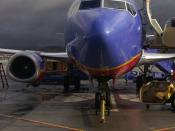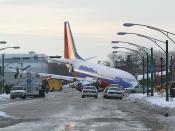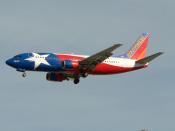DSE 2030H OPERATION MANAGEMENT CASE STUDY - SOUTHWEST AIRLINES IN BALTIMORE
Case Study
Southwest Airlines
Group members: CHOI Ying Kai, Jack (06523393)
WONG Man Hin, Henry (06813043)
TONG Yan Yan, Tiffany (06832351)
TAM Tan Ni, Danny (06764111)
LEE Wan Hung, Rex (06662482)
Course : DSE 2030H Operation Management
Instructor : Dr. Jeff Yeung
Completion Date : 28 Jan, 2008
1
A. Unique operation system
Unlike its industrial rivals who used the "hub and spoke" system, Southwest Airlines established its own point-to-point system instead. Even though economic theories tell Southwest's system should be unworkable - the shorter the flight is, the higher the setup cost per seat mile, thanks to the well-known quick and efficient turnaround process, Southwest succeeded in creating a miracle. The point-to-point system not only enables Southwest to lower its costs and make frequent flights, but also to capture a niche market and compete with other transportation like trains and buses.
This is because Southwest is able to provide passengers with short-hauling flights which can be substitutes to trains and buses. Consequently, it earns a considerable profit from the expanded market size.
B. Low costs
Southwest is operating at a lower cost when comparing with its competitors. It minimizes its cost in four main ways.
The quick turnaround process: Southwest focuses on turning aircraft around quickly at the gate to minimize an airplane's time on the ground. They do so by the relational coordination of their operation agents, which would be further discussed in Q2.
The use of a single aircraft type: Southwest uses only Boeing 737 and standardizes the cockpit configuration. These minimize additional training requirements for pilots and routinize ramp operations, which helps to save training costs and speed turnarounds at the gate.
The use of less-congested...



Design
I found that the content was written very well, additionally the organization was very user friendly. I personally favour the point system of case analysis and the highlights of the key areas. Reference to actual case content are also very good.
0 out of 0 people found this comment useful.